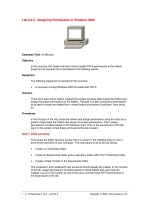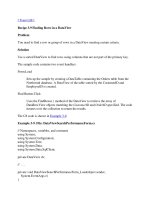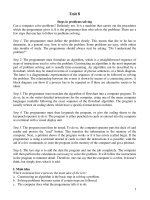Tài liệu Counting Records in a DataReader ppt
Bạn đang xem bản rút gọn của tài liệu. Xem và tải ngay bản đầy đủ của tài liệu tại đây (24.31 KB, 4 trang )
[ Team LiB ]
Recipe 2.7 Counting Records in a DataReader
Problem
You want to determine how many records there are in a DataReader.
Solution
Use one of the following three techniques:
•
Iterate over the rows in the DataReader.
•
Issue a COUNT(*) query as part of a batch query. Note that not all data sources
support batch queries. If not, execute the statements separately one after the other
for a similar result.
•
Use the @@ROWCOUNT function to return the number or rows in a DataReader
after the DataReader has been closed. This technique is SQL Server specific.
The sample code uses a single stored procedure:
SP0207_GetOrders
Returns a result set containing all records in the Orders table in Northwind. Also,
the stored procedure returns the @@ROWCOUNT value for the query in an
output parameter. The stored procedure is shown in Example 2-7
.
Example 2-7. Stored procedure: SP0207_GetOrders
ALTER PROCEDURE SP0207_GetOrders
@RowCount int output
AS
set nocount on
select * from Orders
set @RowCount = @@ROWCOUNT
RETURN
The C# code is shown in Example 2-8
.
Example 2-8. File: DataReaderRowCountForm.cs
// Namespaces, variables, and constants
using System;
using System.Configuration;
using System.Data;
using System.Data.SqlClient;
// . . .
// Batch query to retrieve the COUNT of records and
// all of the records in the Orders table as two result sets.
String sqlText = "SELECT COUNT(*) FROM Orders; " +
"SELECT * FROM Orders;";
// Create the connection.
SqlConnection conn = new SqlConnection(
ConfigurationSettings.AppSettings["Sql_ConnectString"]);
SqlCommand cmd = new SqlCommand(sqlText, conn);
conn.Open( );
// Create a DataReader on the first result set.
SqlDataReader dr = cmd.ExecuteReader( );
// Get the count of records from the select count(*) statement.
dr.Read( );
resultTextBox.Text = "Orders table record count, using COUNT(*)= " +
dr.GetInt32(0) + Environment.NewLine;
// Move to the data result set.
dr.NextResult( );
int count = 0;
// Iterate over the records in the DataReader.
while(dr.Read( ))
{
count++;
// . . . Do something interesting with the data here.
}
// Close the DataReader and the connection.
dr.Close( );
resultTextBox.Text += "Orders table record count, " +
"iterating over result set = " + count +
Environment.NewLine;
// Create the stored procedure to use in the DataReader.
cmd = new SqlCommand("SP0207_GetOrders", conn);
cmd.CommandType = CommandType.StoredProcedure;
// Create the output paramter to return @@ROWCOUNT.
cmd.Parameters.Add("@RowCount", SqlDbType.Int).Direction =
ParameterDirection.Output;
// Create a DataReader for the result set returned by
// the stored procedure.
dr = cmd.ExecuteReader( );
// . . . Process the data in the DataReader.
// Close the DataReader.
dr.Close( );
// The output parameter containing the row count is now available.
resultTextBox.Text += "Orders table record count, " +
"returning @@ROWCOUNT from stored procedure = " +
cmd.Parameters["@RowCount"].Value;
conn.Close( );
Discussion
The DataReader provides forward-only, read-only access to a stream of rows from a data
source. It is optimized for performance by reading data directly from a connection to a
data source. As a result, there is no way to determine the number of records in the result
set for the DataReader without iterating through all of the records. Additionally, because
the DataReader is forward-only, you cannot move backwards in DataReader so when
iterating, you must process data at the same time. This technique provides the only
accurate count of records in the DataReader.
A second technique demonstrated in the solution counts the records using the COUNT
aggregate function for the command text used to build the DataReader. This technique
can have discrepancies with the number of records actually in the DataReader because of
the timing lag between issuing the COUNT function and creating the DataReader.
The solution also demonstrates using the SQL Server @@ROWCOUNT variable, which
returns the number of rows affected by the previous statement, to return the number of
records in the result set used to create the DataReader. The count is returned as an output
parameter and is therefore not available until the DataReader is closed. Although this
does not improve the availability of the record count, centralizing the count in the stored
procedure is less prone to coding errors than the counting approach. For more
information about output parameters, see Recipe 2.9
.
The HasRows( ) method of the DataReader was introduced in Version 1.1 of the .NET
Framework. It returns a Boolean value indicating whether the DataReader contains at
least one row.
There is also no way to determine the number of result sets in a DataReader built using a
batch query without iterating over the result sets using the NextResult( ) method.
[ Team LiB ]









